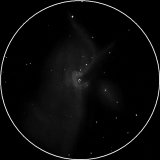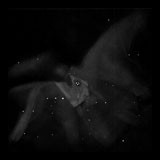
| MESSIER 42, THE ORION NEBULA |
|---|
RA: |
05h 35m 18s |
|
DEC: |
-05° 23' 00'' |
|
Type: |
Emission Nebula |
|
NGC: |
1976 |
|
Magnitude: |
4.00 |
|
Surface brightness : |
11.00 |
|
Apparent dimensions : |
90'x60' |
|
Distance: |
1,600 ly |
|
Possibly discovered 1610 by Nicholas-Claude Fabri de Peiresc. Independently found by Johann Baptist Cysatus in 1611. The Orion Nebula M42 is the brightest diffuse nebula in the sky, and one of the brightest deepsky objects at all. Shining with the brightness of a star of 4th magnitude, it visible to the naked eye under moderately good conditions, and rewarding in telescopes of every size, from the smallest glasses to the greatest Earth-bound observatories as well as outer-space observatories like the Hubble Space Telescope. It is also a big object in the sky, extending to over 1 degree in diameter, thus covering more than four times the area of the Full Moon. As it is so well visible to the naked eye, one may wonder that its nebulous nature was apparently not documented before the invention of the telescope. However, the brightest stars within the nebula were noted early and cataloged as one bright star of about fifth magnitude: In about 130 AD, Ptolemy included it in his catalog, as did Tycho Brahe in the late 16th century, and Johann Bayer in 1603 - the latter cataloging it as Theta Orion in his Uranometria. In 1610, Galileo detected a number of faint stars when first looking at this region with his telescope, but didn't note the nebula. Some years later, on February 4, 1617, Galileo took a closer look at the main star, Theta1, and found it to be triple, at his magnification of 27 or 28x, again not perceiving the nebula. This gorgeous object continued to influence astronomers since. It was the first deepsky observation by William Herschel with a self-constructed reflecting telescope of 6-foot focal length in 1774. In 1789, with some prophetic touch, he described his observations with his 48-inch aperture, 40-foot FL scope as "an unformed fiery mist, the chaotic material of future suns." The gaseous nature of the Orion Nebula was revealed in 1865 with the help of spectroscopy by William Huggins. In September 1880, M42 was the first nebula to be successfully photographed, by Henry Draper. The Orion Nebula is located at a distance of about 1,600 (or perhaps 1,500) light-years. At this distance, its angular diameter of 90x60 arc minutes corresponds to a linear diameter of about 40 light-years. M42 itself is apparently a very turbulent cloud of gas and dust, full of interesting details. The major features got names on their own by various observers: The dark nebula forming the lane separating M43 from the main nebula extends well into the latter, forming a feature generally nicknamed the "Fish's Mouth". The bright regions to both sides are called the "wings", while at the end of the Fish's Mouth there's a cluster of newly formed stars, called the "Trapezium cluster". The wing extension to the south on the east (lower left in our image) is called "The Sword", the bright nebulosity below the Trapezium "The Thrust" and the fainter western (right) extension "The Sail". The Trapezium Cluster is among the very youngest (open) clusters known, with new stars still forming in this region. As stated above, the cluster was first depicted as triple star on February 4, 1617 by Galileo, who was not aware of the nebula. Galileo's discovery did not get widely known, so that Christian Huygens independently rediscovered the triple star in 1656 together with the Orion Nebula. These first three stars are often labelled "A", "C", and "D". It may be of interest that in both cases, the Trapezium, or Theta1 Orionis, was second to only one other double star: Mizar (Zeta Ursae Majoris). The fourth Trapezium star, "B", was first found by Abbe Jean Picard in 1673 (according to De Mairan), and independently by Huygens in 1684. The fifth cluster star "E" was discovered by Friedrich Georg Wilhelm Struve in 1826 with a 9.5-inch refractor in Dorpat, the sixth, "F", by John Herschel on February 13, 1830, the seventh, "G", by Alvan Clark in 1888 when testing his 36-inch refractor of Lick Observatory, and the eighth, "H" by E.E. Barnard later in 1888 with the same telescope. Barnard later found that "H" is double, with two 16th-magnitude components. The past decades of research on the Orion Nebula have revealed that the visible nebula, M42, the blister of hot, photo-ionized, luminous gas around hot Trapezium stars, is only a thin layer lying on the surface of a much larger cloud of denser matter, the Orion Molecular Cloud 1 (OMC 1). We happen to see this structure approximately face-on. The Orion nebula was, continuously since the early times before its refurbishment, a preferred target for the Hubble Space Telescope. One major discovery was that of protoplanetary disks, the socalled "Proplyds" (planetary systems in formation). It is very easy to find the Orion Nebula, as it surrounds the Theta Orionis multiple star or cluster, seen to the naked eye in the middle of the sword of Orion. Already under fairly good conditions, the nebula itself can be glimpsed with the naked eye as a faint nebulosity around this star. |
||
Other sketches |
|||||
 |
 |
 |
 |
||
M42, 114x, Jan 2006. |
M42, 114x, Oct 2006. |
M42, 114x, Nov 2006. |
M42, 38x, Nov2006. |
||
 |
|||||
M42, 300x, Jan 2007. |
VEDRAN VRHOVAC© 2006.-2007. |
